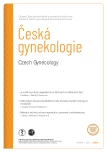Emergent hysterectomy for placenta accreta spectrum – some additional techniques
Published in the journal:
Ceska Gynekol 2023; 88(6): 480
Category:
Dopis redakci
Dear Editors,
I read the article by Kaba et al [1]. They reported a new technique for emergent hysterectomy in a patient with placenta accreta spectrum (PAS) in the 2nd trimester. This technique is not specific to the 2nd trimester and thus I wish to discuss some procedures of PAS-hysterectomy in general.
Kaba et al first ligated the uterine artery, then separated the bladder, and finally removed the uterus. The main reason for this is: bladder separation in the face of a thick adhesion at the bladder--uterine interface often causes i) marked bleeding and ii) bladder injury. Ligating the uterine artery before bladder separation prevents i) and ii). I wish to shortly state some other simple alternatives which prevent i) and ii).
The first is the “amputation first technique” [2]. The upper 2/3 of the uterus should be removed. This part usually occupies the pelvic cavity, preventing better visualization of the surgical field. Thus, the uterus should be amputated at the level of the lower segment cesarean incision and the upper branch of the uterine artery. The latter should be ligated at the time of the amputation. The uterine wall should be sutured or clamped, which achieves transient hemostasis until hysterectomy is completed. We can obtain good visualization of the surgical field. Passing the finger through the cervical canal enables us to grasp the vaginal fornix, the site to be transected at hysterectomy. Grasping this site prevents “too much” bladder separation and “too deep” vaginal resection.
The second is the “filling the bladder technique” [3,4]. Before separating the bladder, the bladder should be filled with 300 mL of saline with or without methylene blue. Usually, thick adhesion of the bladder-uterine interface makes it difficult to grasp the bladder upper top (anterior end). Surgeons tend to start bladder separation at the site more anterior than the bladder top, which causes extra-bleeding. The “filling the bladder technique” makes the surgeons grasp the site of the bladder top, or the site to start the bladder separation. Leak of saline or blue dye in the surgical site makes us recognize the bladder injury when it unfortunately occurs: earlier recognition of bladder injuries provides room to better deal with the surgery thereafter.
The third is the “opening the bladder technique” [4,5]. If bladder injury is a concern and intra-surgical findings highly predict its occurrence, the bladder should be intentionally cut. An auto-suture apparatus is useful. The bladder wall “sharply cut” is much easier to repair than that “severely destroyed” during forced bladder separation. The site of the placental invasion to the posterior bladder wall (percreta site) should be considered as “endometrial cancer invading the bladder wall”. Intentional cystotomy is often employed in the surgery for advanced endometrial cancer.
These three procedures may be useful additions of PAS hysterectomy. We recommend PAS-surgeons to attempt these techniques if the situation requires them to do so. Accumulation of the experience may improve the procedure of PAS hysterectomy, which is still a challenging surgery.
Acknowledgment
I previously described these three techniques as cited. Our team also included these techniques in other papers, which can be retrieved through the articles cited here.
Prof. Shigeki Matsubara, MD, PhD
Department of Obstetrics and Gynecology
Jichi Medical University
3311-1 Yakushiji, Shimotsuke
Tochigi 329-0498
Japan
matsushi@jichi.ac.jp
Zdroje
1. Kaba M, Erkan C, Sarica MC et al. Emergency hysterectomy after 2nd trimester abortion in a patient with placenta accreta spectrum disorder who had four cesarean deliveries. Ceska Gynekol 2023; 88 (2): 110–113. doi: 10.48095/cccg2023110.
2. Matsubara S, Ohkuchi A, Suzuki H et al. Cesarean hysterectomy: amputation-first technique (Matsubara). Acta Obstet Gynecol Scand 2015; 94 (5): 552–553. doi: 10.1111/aogs.12602.
3. Matsubara S, Takahashi H, Baba Y. Handling aberrant vessels located in the posterior bladder wall in surgery for abnormally invasive placenta: a non/less-touch technique. Arch Gynecol Obstet 2017; 296 (5): 851–853. doi: 10.1007/s00404-017-4498-2.
4. Matsubara S, Kuwata T, Usui R et al. Important surgical measures and techniques at cesarean hysterectomy for placenta previa accreta. Acta Obstet Gynecol Scand 2013; 92 (4): 372–377. doi: 10.1111/aogs.12074.
5. Matsubara S. Intentional cystotomy in surgery for placenta percreta with bladder invasion: not only for hysterectomy but also for uterus-preserving surgery. Acta Obstet Gynecol Scand 2023; 102 (1) : 122–123. doi: 10.1111/ aogs.14484.
Štítky
Dětská gynekologie Gynekologie a porodnictví Reprodukční medicínaČlánek vyšel v časopise
Česká gynekologie

2023 Číslo 6
- Isoprinosin je bezpečný a účinný v léčbě pacientů s akutní respirační virovou infekcí
- Horní limit denní dávky vitaminu D: Jaké množství je ještě bezpečné?
- S MUDr. Kamilou Kotíkovou o novém pilíři včasné diagnostiky osteoporózy − denzitometrii v gynekologické praxi
- Tirzepatid – nová éra v léčbě nadváhy a obezity
- Magnosolv a jeho využití v neurologii
Nejčtenější v tomto čísle
- Diagnostika a léčba endometriózy: Doporučený postup Sekce pro léčbu endometriózy ČGPS ČLS JEP
- Preeclampsia and diabetes mellitus
- Assisted oocyte activation
- Is there a difference between acute appendicitis in pregnant and non-pregnant women?

